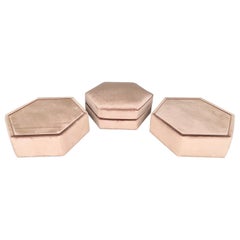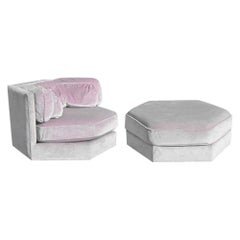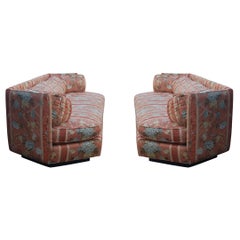Bernhardt Hexagonal
Hexagonal Ottoman and Pair of Upholstered Side Tables by Bernhardt Flair
By Bernhardt
Located in Hanover, MA
Modular Mod from Bernhardt Flair division, 1978, pair of upholstered hexagonal side tables with
Category
Vintage 1970s American Hollywood Regency Side Tables
Materials
Upholstery, Glass
$3,800 / set
H 17 in W 39 in D 34 in
Recent Sales
1 Velvet Hexagonal Flair Collection Lounge Chair and Ottoman by Bernhardt
By Bernhardt
Located in Pasadena, TX
One velvet hexagonal light lavender lounge chair with ottoman. Upholstered in light lavender/pink
Category
Mid-20th Century American Mid-Century Modern Lounge Chairs
Materials
Velvet
Matching Pair of Hexagonal Mid-Century Modern Sofas by Bernhardt, Plinth Bases
By Bernhardt
Located in Philadelphia, PA
A sleek modern set of vintage sofas made by Bernhardt in the 1970s. The feature hexagonal forms
Category
Vintage 1970s American Mid-Century Modern Sofas
Materials
Fabric, Wood
H 30 in W 90 in L 30 in
Hexagonal Sofa In "Dr. Pepper" Velvet from American Hustle
By Bernhardt
Located in Hanover, MA
Absolutely immaculate shimmering velvet covered sofa of hexagonal form by Bernhardt for the Flair
Category
Late 20th Century American Mid-Century Modern Sofas
Hexagonal Club Chairs in 'Dr. Pepper' Velvet from American Hustle
By Bernhardt
Located in Hanover, MA
Immaculate set of four (or, two pairs) of well proportioned hexagonal shaped club lounge chairs by
Category
Late 20th Century American Mid-Century Modern Lounge Chairs
Pair of 1970s Modern Hexagon Chairs in "Electricity" Graphic European Fabric
By Bernhardt
Located in Palm Springs, CA
This are pair of club chairs were from the 1970s flair designer line beautifully made in the USA by Berhardt. We have chosen a high end multi blend European graphic jacquard for thes...
Category
Vintage 1970s American Modern Club Chairs
H 27.5 in W 40 in D 36 in
Velvet Hexagonal Light Lavender Sofa by Bernhardt
By Bernhardt
Located in Pasadena, TX
Velvet hexagonal sofa by Bernhardt. This sofa is upholstered in light lavender/pink shimmering
Category
Vintage 1970s American Mid-Century Modern Sofas
Materials
Velvet
Hexagonal Mid-Century Modern Club Lounge Chair by Bernhardt on Plinth Base
By Bernhardt
Located in Philadelphia, PA
A sleek modern lounge chair or club chair made by Bernhardt in the 1970s. It features a hexagonal
Category
Vintage 1970s American Mid-Century Modern Club Chairs
Materials
Fabric, Wood
Trio of Hexagonal Mid-Century Modern Club Chairs by Bernhardt, Plinth Bases
By Bernhardt
Located in Philadelphia, PA
A sleek modern set of lounge chairs or club chairs made by Bernhardt in the 1970s. They feature
Category
Vintage 1970s American Mid-Century Modern Club Chairs
Materials
Fabric, Wood
Hexagonal Green Velvet Sofa by Bernhardt Flair
By Milo Baughman, Bernhardt
Located in Bensalem, PA
Luxurious hexagonal green velvet sofa in the manner of Milo Baughman by Bernhardt “Flair” with
Category
Vintage 1970s American Mid-Century Modern Sofas
Materials
Mohair, Velvet
Milo Baughman Style Curved Hexagon Sectional Sofa by Bernhardt Flair, 1970s
By Milo Baughman, Bernhardt
Located in Lambertville, NJ
Fabulous Mid-Century Modern four-piece curved modular sofa from Bernhardt's Flair Collection. This
Category
Vintage 1970s Mid-Century Modern Sectional Sofas
Materials
Upholstery, Wood
1970s Hexagonal Green Velvet Sofa Club Chair W/ Plinth Base-A Pair
By Thayer Coggin, Bernhardt Design
Located in Bensalem, PA
Stunning pair 1970s hexagonal lounge chairs designed by "FLAIR" for Bernhardt in green velvet
Category
Vintage 1970s American Mid-Century Modern Chaise Longues
Materials
Velvet
People Also Browsed
Murano Glass Smoked “Macchie” Sconces
Located in Austin, TX
Pair of Murano sconces in smoked and silver glass. We loved the organic shape of the sconces and their dynamic design. This pair has been newly wired to fit US standards and is in ve...
Category
2010s Italian Mid-Century Modern Wall Lights and Sconces
Materials
Murano Glass
Barovier & Toso Wall Lighting Glass Murano Pair , Italy, 1980
By Barovier&Toso, Barovier
Located in La xara, VC
Exceptional Barovier & Toso wall lighting glass Murano with metal structure. The Design and the quality of the glass make this piece the best of the italian Design.
Beautiful unique...
Category
Vintage 1980s Italian Mid-Century Modern Wall Lights and Sconces
Materials
Brass
$999 Sale Price / set
44% Off
H 15.75 in W 9.06 in D 4.73 in
American Designer, Counter Stools, Iron, Velvet, USA, 1950s
Located in High Point, NC
A set of four black-painted iron and blue velvet counter stools or bar stools designed and produced in the US, c. 1950s.
Oxidation present to metal.
Wear consistent with age and u...
Category
Vintage 1950s American Mid-Century Modern Stools
Materials
Iron
Beautiful Pair of Late 19th Century Gilt Bronze, Enamel and Sèvres Style Vases
By Manufacture Nationale de Sèvres
Located in Long Island City, NY
A Beautiful Pair of Late 19th Century Gilt Bronze and Champlevé Enamel Mounted White Sèvres Style Vases
Gilt bronze tops above a long neck with raised gold designs. The painted fron...
Category
Antique Late 19th Century French Belle Époque Porcelain
Materials
Enamel, Bronze, Ormolu
$25,000 / set
H 26 in W 12 in D 9 in
Petal Mirror in Cream Shagreen and Bronze-Patina Brass by R&Y Augousti
By R & Y Augousti
Located in New York, NY
The Paris based label has distinguished themselves since their launch, with their iconic use of shagreen mixed with brass and other exotic materials. All furniture is handcrafted by ...
Category
21st Century and Contemporary Philippine Art Deco Wall Mirrors
Materials
Brass
$5,125 / item
H 28.35 in W 26.38 in D 3.94 in
Vintage Murano Italian POLIEDRI white and pink albaster wall sconces
By Mazzega
Located in Gaiarine Frazione Francenigo (TV), IT
Luxury and GENUINE Murano Glass pair of applique. 100% HAND MADE IN MURANO. The sconces are made by 17 Murano handmade white and pink alabaster POLIEDRI glass, for each one, in a Sol...
Category
Late 20th Century Italian Mid-Century Modern Wall Lights and Sconces
Materials
Blown Glass
$1,565 / set
H 15.75 in W 9.85 in D 5.91 in
Peill & Putzler Large Pair of 1970s Smoked Glass Biomorphic Wall Sconces Lights
By Peill & Putzler
Located in Landau an der Isar, Bayern
Large pair of mid-century 'Futura' or commonly referred to as 'Wave' flush mount ceiling or wall lights / sconces by Peill & Putzler in the 1970s. This is an absolutely Classic piece...
Category
Vintage 1970s German Mid-Century Modern Flush Mount
Materials
Metal, Aluminum, Brass
$3,913 / set
H 6.3 in Dm 12.6 in
'Penguin' Easy Chair by Kurt Olsen in Teak & Wool for Gloastrup Møbelfabrik
By Kurt Olsen
Located in Brooklyn, NY
A lovely example of Kurt Olsen’s celebrated ‘Penguin’ chair in original boiled wool upholstery and sculpted teak—excellent vintage condition. Stunning construction featuring floating...
Category
Vintage 1960s Danish Scandinavian Modern Lounge Chairs
Materials
Wool, Teak
$2,200 Sale Price
20% Off
H 31 in W 27 in D 33 in
French 19th Century Louis XV Style Gilt-Bronze Crystal Chandelier Attr. Baccarat
By Cristalleries De Baccarat
Located in Los Angeles, CA
A very fine and Palatial French 19th century Louis XV Style gilt bronze, crystal and cut-glass Twenty-Four-light chandelier, probably by Baccarat. The central molded cut-glass stem s...
Category
Antique Late 19th Century French Louis XV Chandeliers and Pendants
Materials
Crystal, Bronze
$99,850 Sale Price
31% Off
H 76 in Dm 53 in
Pair of French gilt bronze table candelabra
Located in London, GB
Pair of French gilt bronze table candelabra
French, 19th Century
Height 75cm, diameter 35cm
The fine gilt bronze candelabra in this pair are crafted in the eclectic style that preva...
Category
Antique 19th Century French Louis XVI Candelabras
Materials
Ormolu
Fine Late 19th Century Louis XV Style Console Table
Located in Long Island City, NY
A Very Finely Carved Late 19th Century Regence Style Giltwood Console
The shaped rectangular brèche marble top above a latticework frieze and pierced foliate apron centered by a coa...
Category
Antique 19th Century French Louis XV Console Tables
Materials
Marble
Antique French Clock Set in Champleve Enamel and Ormolu
Located in London, GB
This charming late 19th century French clock set takes inspiration from a range of styles and periods, and is beautiful in its final execution. It consists of a central clock and two...
Category
Antique Late 19th Century French Mantel Clocks
Materials
Enamel, Ormolu
19th Century English Marquetry Side Cabinet in the Neoclassical Style
Located in London, GB
A Fine and Decorative Side Cabinet in the Hepplewhite Manner
Constructed in goncalo alves, with satinwood crossbanding and specimen woods used in the inlays; of serpentine form, ris...
Category
Antique 19th Century British Neoclassical Cabinets
Materials
Wood, Satinwood
$19,024
H 39 in W 46.25 in D 19.5 in
Pair of Louis XV Style 16-Light Chandeliers, Manner of Baccarat
By Cristalleries De Baccarat
Located in Los Angeles, CA
A large pair of Louis XV style gilt bronze and cut-glass sixteen-light chandeliers. The solid bronze frames surmounted with pendants, molded towers, fleur de lis and a central suppor...
Category
20th Century French Louis XV Chandeliers and Pendants
Materials
Crystal, Bronze
Palatial and Rare 19th Century Gilt Bronze and Baccarat Crystal Chandelier
Located in Long Island City, NY
A palatial and rare late 19th century gilt bronze and baccarat crystal thirty-nine-light chandelier.
Multifaceted and shaped crystal, beaded arms with crystal swags, cut crystal c...
Category
Antique Late 19th Century Belle Époque Chandeliers and Pendants
Materials
Crystal, Bronze
“Primavera” Murano Glass Sconces
Located in Austin, TX
Sconces from Murano, Italy outside of Venice. This pair is made with a brass structure and eight pieces of glass each. The glass elements are hand-blown and molded in green, purple, ...
Category
2010s Italian Mid-Century Modern Wall Lights and Sconces
Materials
Brass
Get Updated with New Arrivals
Save "Bernhardt Hexagonal", and we’ll notify you when there are new listings in this category.
More Ways To Browse
Plinth Base Lounge Chair
Sterling Silver Chafing Dishes
Sterling Silver Christening Cup
Sterling Silver Crumbers
Sterling Silver Flatware Oak Leaf
Sterling Silver Fruit Forks
Sterling Silver Salt Japan
Sterling Silver Stirrer
Sterling Tastevin
Sterling Yacht Club
Steuben Blue Vase
Steuben Crystal Animal
Steuben Jade
Steuben Plates
Steven Correia Art Glass
Steven Correia Glass
Stickley Dresser
Stirrup Japan


